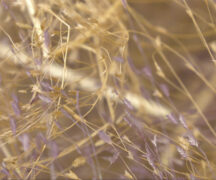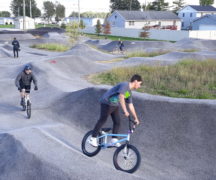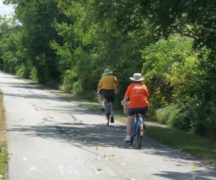By JAN LARSON McLAUGHLIN
BG Independent News
Fire can be a tricky land management tool. So the Wood County Park District and City of Bowling Green are officially teaming up for future prescribed burns.
The two entities have agreed on a memorandum of understanding for fire management in the parks. For years, the two park systems have helped each other with prescribed burns to control unwanted growth.
“This finalizes that agreement,” said Wood County Park District Director Chris Smalley.
The arrangement benefits both entities, since coordinating prescribed burns is a specialized skill – and the more practice the park employees get, the better, Smalley said.
The Bowling Green Parks and Recreation Department periodically conducts prescribed burns at the Wintergarden/St. John’s Nature Preserve as a land management tool.
These controlled burns have enhanced the natural habitat for wildlife and assist with plant management – efficiently removing non-native invasive species that invade the local habitat and shade out native plants. Controlled burns are considered a natural resource manager’s most cost-effective tool for managing a natural habitat, according to Cinda Stutzman, Bowling Green’s natural resources specialist.
Given the correct weather conditions, the nature preserve conducts a prescribed burn in the spring to maintain the prairie grasses and flowers.
The Wood County Park District uses controlled burns to manage growth at multiple parks, including Cricket Frog Cove, Bradner Preserve, Baldwin Woods and in some places along the Slippery Elm Trail.
Some burns are conducted in the spring, others in the fall, Smalley said.
“It depends on what we’re managing for,” he said.
Adrien Lowien-Kirian, who coordinates the prescribed burns on county parklands, described the process last year to the park board.
“Fire is a really good management tool,” Lowien-Kirian said. “It’s really good for some invasive species mitigation.”
Controlled burning is the most efficient method to restore oak woodlands and savannas, Lowien-Kirian said. The fires can reduce layers of leaves and organic matter, increase nutrient cycling, improve seed germination, and increase biodiversity.
Alternate methods can be used, such as herbicides, mowing, raking and blowing. But all are more time consuming than controlled burns, Lowien-Kirian said. In some cases, a combination of methods is the best option, she said.
In all prescribed burns, the Wood County Park District follows detailed regulations by the Ohio Department of Natural Resources and the Ohio EPA. All staff involved are trained, according to Lowien-Kirian.
Burns in grasslands and woods are only conducted when the conditions are just right. Factors such as wind, humidity, temperature, fuel moisture and fuel loading must be taken into consideration, she explained. Quite often, planned burns have to be delayed until the right conditions occur.
Also at Tuesday’s meeting, park district commissioner Denny Parish expressed concern that the dike created next to Buttonwood Park does not appear to be any smaller after an order from the Wood County Planning Commission that the mound size must be reduced. The dike was partially blamed for massive damage to the park from ice floes along the Maumee River.
Smalley said he checked with planning commission officials, who said the property owner has until September to diminish the dike.
Until then, the park district is making minimal investment in the site. Buttonwood offers “very simple services,” including access to the Maumee River and a portable restroom, Smalley said.
Jim Witter, the park district program coordinator, also pointed out the site is used for river wading programs and a catfish tournament.
In other business at Tuesday’s meeting:
- Witter passed out new guides for the Portage River Water Trail, which starts at William Henry Harrison Park in Pemberville and ends at Lake Erie. The recently opened water trail “connects people to local natural resources,” he said.
- Assistant Park District Director Andrew Kalmar reported on water damage to beams in the basement of the stone shelter house in Otsego Park. The concrete will be recast to fix deterioration due to water, he said.
- A Friends of the Parks representative talked about the upcoming native plant sale planned for this fall, featuring shrubs and flowers that bloom in autumn, a scarecrow contest, birdseed sale, park photo contest, and a lending library in Cedar Creeks Preserve.





